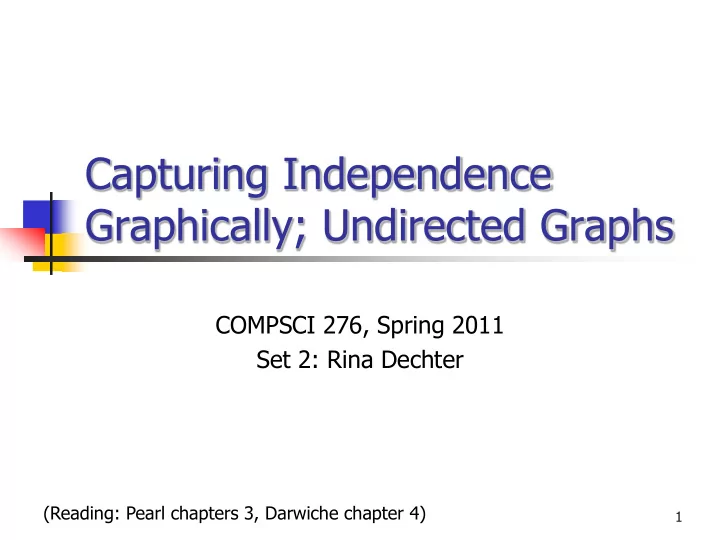

Capturing Independence Graphically; Undirected Graphs COMPSCI 276, Spring 2011 Set 2: Rina Dechter (Reading: Pearl chapters 3, Darwiche chapter 4) 1
The Qualitative Notion of Depedence motivations and issues The traditional definition of independence uses equality of numerical quantities as in P(x,y)=P(x)P(y) People can easily and confidently detect dependencies, but not provide numbers The notion of relevance and dependence are far more basic to human reasoning than the numerical Assertions about dependency relationships should be expressed first. 2
Dependency graphs The nodes represent propositional variables and the arcs represent local dependencies among conceptually related propositions. Graph concepts are entrenched in our language (e.g., “thread of thoughts”, “lines of reasoning”, “connected ideas”). One wonders if people can reason any other way except by tracing links and arrows and paths in some mental representation of concepts and relations. What types of (in)dependencies are deducible from graphs? For a given probability distribution P and any three variables X,Y,Z ,it is straightforward to verify whether knowing Z renders X independent of Y, but P does not dictates which variables should be regarded as neighbors. Some useful properties of dependencies and relevancies cannot be represented graphically. 3
Conditional Independence 4
Implied independencies 5
Properties of Conditional Independance I pr ( X,Y,Z ) 6
Properties of independence Symmetry: I(X,Z,Y) I(Y,Z,X ) Decomposition: I(X,Z,YW) I(X,Z,Y) and I(X,Z,W ) Weak union: I(X,Z,YW) I(X,ZW,Y) Contraction: I(X,Z,Y) and I(X,ZY,W) I(X,Z,YW) Intersection: I(X,ZY,W) and I(X,ZW,Y) I(X,Z,YW ) 7
8
Example: Two coins and a bell
Graphs vs Graphoids Graphoid : satisfy all 5 axioms Symmetry: Semi-graphoid : sayisfies the first 4. I(X,Z,Y) I(Y,Z,X ) Decomposition: Decomposition is only one way while I(X,Z,YW) I(X,Z,Y) and I(X,Z,W ) in graphs it is iff. Weak union states that w should be chosen from a set that, like Y should Weak union: already be separated from X by Z I(X,Z,YW) I(X,ZW,Y) Contraction: I(X,Z,Y) and I(X,ZY,W) I(X,Z,YW) Intersection: I(X,ZY,W) and I(X,ZW,Y) I(X,Z,YW ) 15
Why axiomatic characterization? Allow deriving conjectures about independencies that are clearer Axioms serve as inference rules Can capture the principal differences between various notions of relevance or independence 16
17
I-map and D-maps A model with induced dependencies cannot cannot be i-map and d-map • Example: two coins and a bell… try it • How we then represent two causes leading to a common consequence? • 18
Axiomatic characterization of Graphs Definition: A model M is graph-isomorph if there exists a graph which is a perfect map of M. Theorem (Pearl and Paz 1985) : A necessary and sufficient condition for a dependency model to be graph – isomorph is that it satisfies Symmetry: I(X,Z,Y) I(Y,Z,X ) Decomposition: I(X,Z,YW) I(X,Z,Y) and I(X,Z,Y ) Intersection: I(X,ZW,Y) and I(X,ZY,W) I(X,Z,YW) Strong union: I( X,Z,Y) I (X,ZW , Y ) Transitivity: I( X,Z,Y ) exists t s.t. I( X,Z ,t) or (I(t, Z,Y ) This properties are satisfied by graph separation 19
Markov Networks Graphs and probabilities: Given P, can we construct a graph I-map with minimal edges? Given (G,P) can we test if G is an I-map? a perfect map? Markov Network: A graph G which is a minimal I- map of a dependency model P, namely deleting any edge destroys its i-mapness, is called a Markov network of P. 20
Markov Networks Theorem (Pearl and Paz 1985): A dependency model satisfying symmetry decomposition and intersection has a unique minimal graph as an i-map, produced by deleting every edge (a,b) for which I(a ,U -a-b,b) is true. The theorem defines an edge-deletion method for constructing G 0 Markov blanket of a is a set S for which I(a,S,U-S-a). Markov Boundary : a minimal Markov blanket. Theorem (Pearl and Paz 1985): if symmetry, decomposition, weak union and intersection are satisfied by P, the Markov boundary is unique and it is the neighborhood in the Markov network of P 21
Markov Networks Corollary: the Markov network G of any strictly positive distribution P can be obtained by connecting every node to its Markov boundary. The following 2 interpretations of direct neighbors are identical: Neighbors as blanket that shields a variable from the influence of all others Neighborhood as a tight influence between variables that cannot be weakened by other elements in the system So, given P (positive) how can we construct G? Given (G,P) how do we test the G is an I-map of P? Given G, can we construct P which is a perfect i-map? (Geiger and Pearl 1988) 22
Testing I-mapness Theorem: Given a positive P and a graph G the following are equivalent: G is an I-map of P iff G is a super-graph of the Markov network of P G is locally Markov w.r.t. P (the neighbors of a in G is a Markov blanket.) iff G is a super-graph of the Markov network of P There appear to be no test for i-mapness of undirected graph that works for extreme distributions without testing every cutset in G (ex: x=y=z=t ) Representations of probabilistic independence using undirected graphs rest heavily on the intersection and weak union axioms. In contrast, we will see that directed graph representations rely on the contraction and weak union axiom, with intersection playing a minor role. 23
The unusual edge (3,4) Reflects the reasoning that if we fix The arrival time (5) the travel time (4) must depends on current time (3)
Summary
How can we construct a probability Distribution that will have all these independencies?
G is locally markov If neighbors make every Variable independent From the rest.
Recommend
More recommend